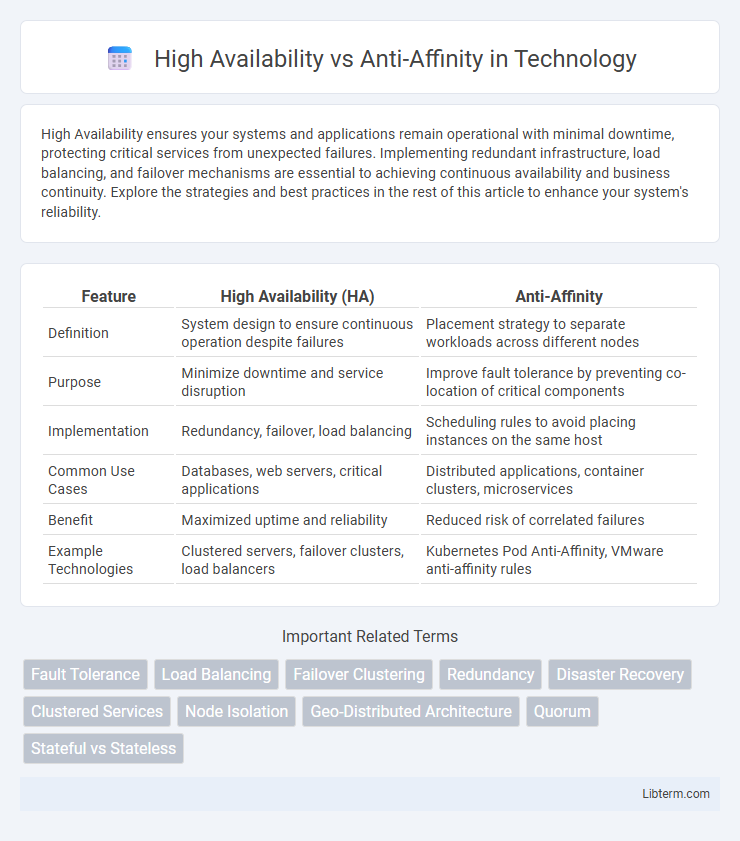High Availability ensures your systems and applications remain operational with minimal downtime, protecting critical services from unexpected failures. Implementing redundant infrastructure, load balancing, and failover mechanisms are essential to achieving continuous availability and business continuity. Explore the strategies and best practices in the rest of this article to enhance your system's reliability.
Table of Comparison
| Feature | High Availability (HA) | Anti-Affinity |
|---|---|---|
| Definition | System design to ensure continuous operation despite failures | Placement strategy to separate workloads across different nodes |
| Purpose | Minimize downtime and service disruption | Improve fault tolerance by preventing co-location of critical components |
| Implementation | Redundancy, failover, load balancing | Scheduling rules to avoid placing instances on the same host |
| Common Use Cases | Databases, web servers, critical applications | Distributed applications, container clusters, microservices |
| Benefit | Maximized uptime and reliability | Reduced risk of correlated failures |
| Example Technologies | Clustered servers, failover clusters, load balancers | Kubernetes Pod Anti-Affinity, VMware anti-affinity rules |
Understanding High Availability: Core Concepts
High Availability (HA) ensures system reliability and minimal downtime by distributing workloads across multiple nodes to prevent single points of failure. Anti-Affinity rules play a crucial role in HA by ensuring that critical applications or services run on separate physical servers or virtual machines to avoid simultaneous disruptions. Understanding the core concepts of HA involves knowing redundancy, failover mechanisms, and fault tolerance strategies designed to maintain continuous service availability.
What is Anti-Affinity? Key Principles Explained
Anti-affinity is a scheduling strategy in distributed systems that ensures workloads or application instances are placed on different physical hosts or failure domains to minimize the risk of simultaneous failures. The key principles involve distributing replicas to avoid resource contention and improve fault tolerance by preventing co-location of critical components. This approach complements high availability by enhancing resilience through spatial separation, reducing the impact of hardware or network outages.
High Availability vs Anti-Affinity: Fundamental Differences
High Availability ensures continuous system operation by minimizing downtime through redundant infrastructure and failover mechanisms. Anti-Affinity focuses on fault tolerance by strategically distributing workloads across different physical or virtual nodes to prevent single points of failure. The fundamental difference lies in High Availability's goal of operational continuity versus Anti-Affinity's role in workload distribution to avoid resource contention and improve resilience.
Use Cases for High Availability in Modern IT
High availability ensures continuous system operation by minimizing downtime through redundant infrastructure, load balancing, and failover mechanisms, critical for service-oriented architectures, online transaction processing, and cloud-native applications. Anti-affinity rules distribute instances across separate physical hosts or failure domains to reduce correlated failures, but high availability strategies encompass broader solutions like automated recovery and geographic replication. Modern IT environments leverage high availability for mission-critical applications, financial services, and healthcare systems where uninterrupted access and data integrity are paramount.
When to Implement Anti-Affinity Rules
Anti-affinity rules should be implemented in environments requiring fault tolerance by distributing critical workloads across multiple hosts or zones to prevent simultaneous failures. They are essential when deploying clustered applications where each instance must run on separate physical machines to avoid correlated downtime. High availability complements anti-affinity by ensuring system resilience through redundancy, but anti-affinity specifically targets spatial separation for workload isolation.
Benefits of High Availability Architectures
High Availability (HA) architectures ensure continuous system operation and minimize downtime by distributing workloads across redundant servers and resources, which enhances reliability and fault tolerance. These architectures provide rapid failover capabilities, reducing service interruptions and improving user experience in critical environments. HA designs support scalable maintenance without affecting system availability, making them essential for mission-critical applications and enterprise IT infrastructures.
Advantages of Anti-Affinity Policies
Anti-affinity policies enhance fault tolerance by ensuring that critical workloads run on separate physical hosts, reducing the risk of simultaneous failures. They improve load distribution and resource utilization by preventing resource contention among co-located virtual machines. These policies increase application resiliency and security by isolating services, which helps maintain system performance and availability during hardware or software faults.
Common Challenges: High Availability and Anti-Affinity
High Availability (HA) and Anti-Affinity address service reliability but encounter common challenges like resource contention and failure domain limitations. HA aims to minimize downtime by replicating services, yet it struggles with ensuring replicas avoid shared hardware failures without Anti-Affinity rules enforcing physical separation. Anti-Affinity policies help distribute workloads across distinct nodes, reducing correlated failure risks, but balancing optimal resource utilization and strict isolation constraints often complicates deployment strategies.
Best Practices for Balancing Availability and Anti-Affinity
Balancing high availability and anti-affinity is essential for minimizing service disruption and resource contention in distributed systems. Implementing anti-affinity rules ensures critical workloads are spread across different nodes or zones, reducing the risk of simultaneous failures, while maintaining redundancy and failover mechanisms guarantees consistent service uptime. Best practices involve combining dynamic load balancing with health checks and leveraging orchestrator features like Kubernetes Pod Anti-Affinity to achieve optimal workload distribution without compromising availability.
Choosing the Right Approach: High Availability or Anti-Affinity?
High Availability (HA) ensures continuous system operation through redundancy and failover mechanisms, minimizing downtime by replicating critical components across multiple nodes. Anti-Affinity policies prevent co-location of similar workloads on the same physical host or failure domain, reducing the risk of simultaneous failures due to hardware or environmental faults. Selecting between HA and Anti-Affinity depends on the specific infrastructure design and business continuity requirements, with HA focusing on service resilience and Anti-Affinity enhancing fault isolation.
High Availability Infographic

 libterm.com
libterm.com